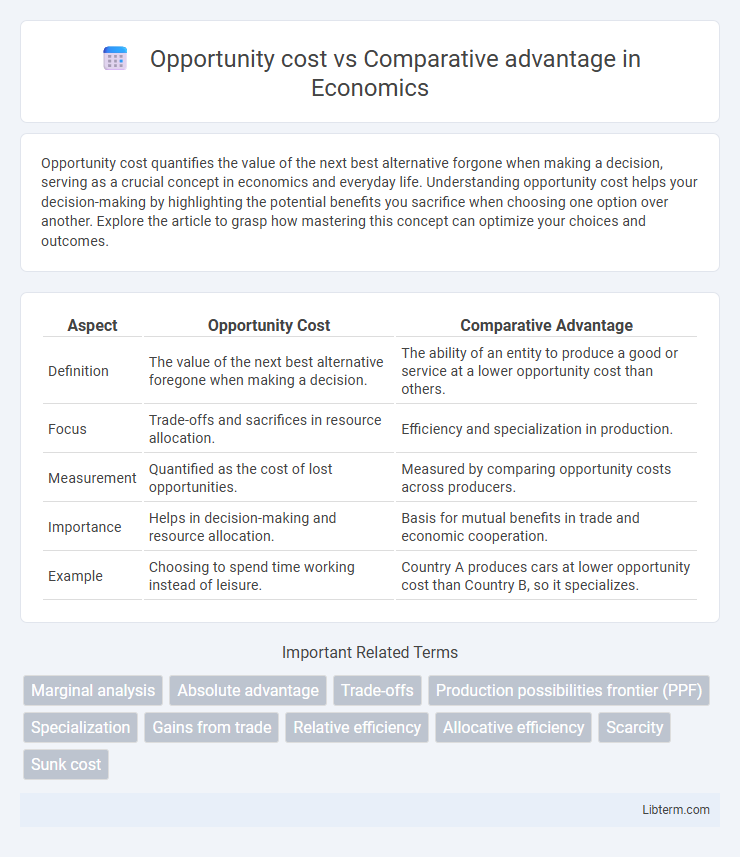Opportunity cost quantifies the value of the next best alternative forgone when making a decision, serving as a crucial concept in economics and everyday life. Understanding opportunity cost helps your decision-making by highlighting the potential benefits you sacrifice when choosing one option over another. Explore the article to grasp how mastering this concept can optimize your choices and outcomes.
Table of Comparison
| Aspect | Opportunity Cost | Comparative Advantage |
|---|---|---|
| Definition | The value of the next best alternative foregone when making a decision. | The ability of an entity to produce a good or service at a lower opportunity cost than others. |
| Focus | Trade-offs and sacrifices in resource allocation. | Efficiency and specialization in production. |
| Measurement | Quantified as the cost of lost opportunities. | Measured by comparing opportunity costs across producers. |
| Importance | Helps in decision-making and resource allocation. | Basis for mutual benefits in trade and economic cooperation. |
| Example | Choosing to spend time working instead of leisure. | Country A produces cars at lower opportunity cost than Country B, so it specializes. |
Understanding Opportunity Cost
Opportunity cost represents the value of the next best alternative forgone when making a decision, crucial for evaluating trade-offs in resource allocation. Understanding opportunity cost helps quantify the benefits lost by choosing one option over another, enabling more efficient economic choices. Comparative advantage builds on this concept by identifying the lowest opportunity cost producer, guiding specialization and trade for maximum overall gain.
Defining Comparative Advantage
Comparative advantage refers to the ability of an individual, firm, or country to produce a good or service at a lower opportunity cost than competitors, enabling more efficient resource allocation. This concept highlights that even if one party is less efficient in producing all goods, specializing based on comparative advantage can increase overall production and trade benefits. Understanding comparative advantage is essential for maximizing economic efficiency and guiding decisions in international trade and business strategies.
Key Differences Between Opportunity Cost and Comparative Advantage
Opportunity cost measures the value of the next best alternative foregone when making a decision, quantifying the trade-off between different choices. Comparative advantage refers to the ability of an individual, firm, or country to produce a good or service at a lower opportunity cost than others, enabling specialization and efficient resource allocation. The key difference lies in opportunity cost being a metric for evaluating trade-offs, while comparative advantage identifies who should specialize based on relative efficiency.
Opportunity Cost in Economic Decision-Making
Opportunity cost represents the value of the next best alternative foregone when making economic decisions, serving as a critical metric for resource allocation. It helps individuals and firms evaluate the trade-offs between competing choices, ensuring optimal use of scarce resources. Understanding opportunity cost enables more efficient decision-making by highlighting potential losses associated with choosing one option over another.
How Comparative Advantage Drives Trade
Comparative advantage drives trade by allowing countries to specialize in producing goods for which they have the lowest opportunity cost, increasing overall efficiency and output. By focusing on the production of goods with comparative advantage, trading partners exchange products, benefiting from mutual gains despite differences in absolute costs. This specialization based on comparative advantage leads to more efficient resource allocation and higher global economic welfare.
Real-World Examples of Opportunity Cost
Opportunity cost represents the value of the next best alternative foregone when making a decision, such as a farmer choosing to grow wheat instead of corn and sacrificing the potential profits from corn sales. Comparative advantage illustrates how countries or individuals can benefit by specializing in producing goods for which they have the lowest opportunity cost, exemplified by Brazil focusing on coffee production while the United States specializes in technology. Real-world examples of opportunity cost include a student dedicating time to studying, thereby forgoing leisure activities, or a business investing in new machinery instead of expanding its workforce.
Comparative Advantage in International Economics
Comparative advantage in international economics refers to a country's ability to produce goods or services at a lower opportunity cost than other nations, enabling more efficient resource allocation and increased global trade benefits. This principle helps explain why countries specialize in producing certain products, fostering international trade that maximizes overall economic welfare and productivity. Understanding comparative advantage allows policymakers to identify sectors where their economy can achieve competitive strength, promoting export growth and economic development.
The Role of Specialization in Comparative Advantage
Specialization enhances comparative advantage by allowing individuals or countries to focus on producing goods and services with the lowest opportunity cost, maximizing efficiency and output. Opportunity cost measures what is sacrificed when choosing one option over another, guiding resource allocation toward specialization that yields the greatest economic benefit. By concentrating resources on areas of comparative advantage, specialization drives trade gains, promoting overall economic growth and improved productivity.
Common Misconceptions: Opportunity Cost vs. Comparative Advantage
Opportunity cost measures the value of the next best alternative foregone when making a decision, while comparative advantage refers to the ability to produce a good or service at a lower opportunity cost than another agent. A common misconception is confusing absolute advantage with comparative advantage, assuming the more productive producer always benefits, ignoring the benefits of trade based on lower opportunity costs. Understanding that comparative advantage drives specialization and trade, regardless of absolute productivity, clarifies why nations or individuals can gain by focusing on activities with the lowest opportunity cost.
Applying Both Concepts in Business and Personal Finance
Opportunity cost determines the value of the next best alternative forgone when making a decision, guiding resource allocation in business investments and personal budgeting. Comparative advantage highlights the ability to produce goods or services at a lower opportunity cost than others, optimizing trade-offs between tasks and maximizing efficiency in both company operations and individual financial choices. Applying both concepts enables entrepreneurs and individuals to prioritize activities that yield the highest return and informed choices about outsourcing, investment, or spending.
Opportunity cost Infographic

 libterm.com
libterm.com